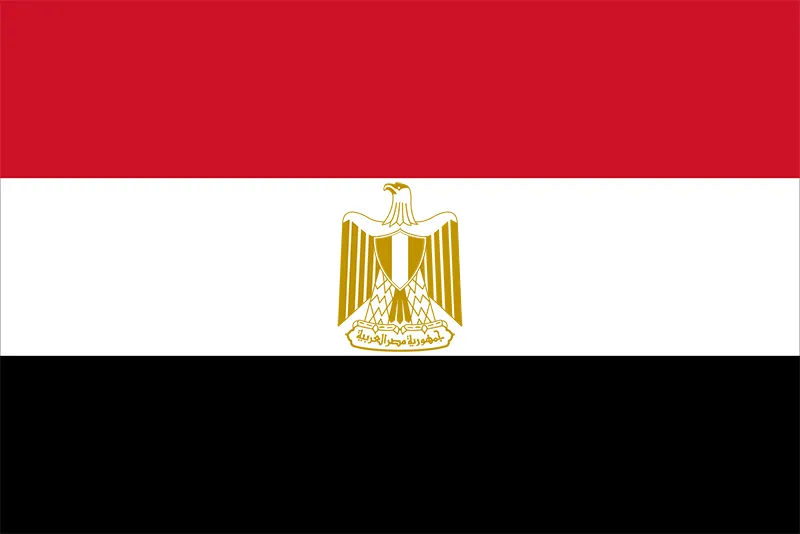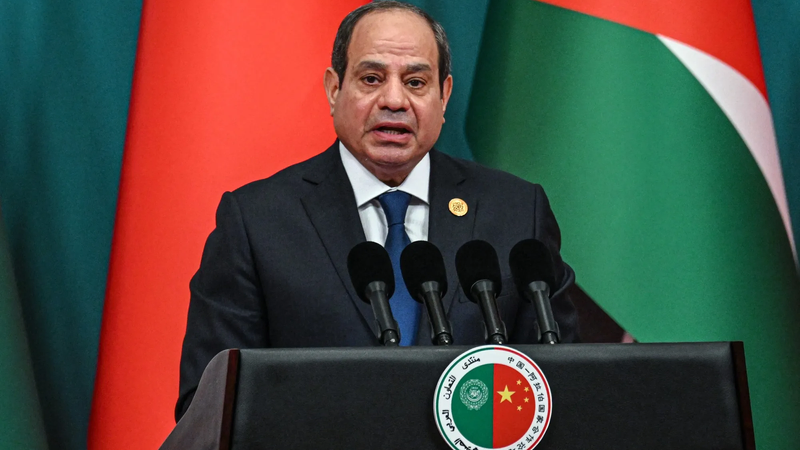Country name: Egypt
Country Flag:

1922: A Nation Takes Flight
After a long period under British rule, Egypt finally gained independence in 1922. King Fuad I ascended the throne, establishing a constitutional monarchy. However, the road to democracy remained bumpy, with periods of political instability and military influence.
1952: A Revolution and a Republic
A turning point came in 1952. A group of military officers led by Gamal Abdel Nasser staged a coup, overthrowing the monarchy and establishing a republic. Nasser pursued socialist policies, nationalised the Suez Canal, and became a prominent figure in the Arab world.
1967 & 1973: War and Peace
Egypt faced defeat against Israel in the 1967 Six-Day War, losing control of the Sinai Peninsula. This national humiliation spurred President Anwar Sadat to make peace with Israel in 1973, a move that ostracised Egypt from many Arab nations.
The Modern Era: Challenges and Change
Following Sadat’s assassination in 1981, Hosni Mubarak became president, ushering in an era of relative stability. However, economic stagnation and political repression grew under his long rule. The 2011 Arab Spring brought mass protests and Mubarak’s eventual ousting.
A New Chapter: Ups and Downs
A tumultuous period followed, with the Muslim Brotherhood briefly coming to power before being removed by the military in 2013. The current president, Abdel Fattah el-Sisi, has overseen economic reforms and infrastructure projects, but also faces criticism regarding human rights.
Today’s Egypt:
Modern Egypt is a complex nation grappling with balancing stability, economic development, and democratic aspirations. Tourism, a vital sector, is slowly recovering from political unrest. Egypt continues to play a significant role in the Middle East, navigating a path that reflects its rich history and evolving ambitions.
1922: A Nation Gains Sovereignty
After centuries of Ottoman rule, Egypt declared independence in 1922, becoming a constitutional monarchy under King Fuad I. However, British influence remained strong, controlling the Suez Canal and maintaining a military presence.
1952: A Revolution and a Republic
A revolution led by Gamal Abdel Nasser in 1952 toppled the monarchy and established a republic. Nasser pursued socialist reforms, nationalised the Suez Canal, and championed pan-Arabism. His era saw economic growth and modernization, but also authoritarian rule.
1967: War and Transformation
The Six-Day War in 1967 marked a turning point. Egypt suffered a humiliating defeat by Israel, losing territory in the Sinai Peninsula. Anwar Sadat succeeded Nasser and adopted a more pragmatic approach.
1979: Peace with Israel
In a controversial move, Sadat signed a peace treaty with Israel in 1979, regaining the Sinai but angering the Arab world. Hosni Mubarak, who assumed power after Sadat’s assassination in 1981, continued Sadat’s policies, focusing on economic development and maintaining stability.
2011: The Arab Spring and Change
The Arab Spring uprisings of 2011 reached Egypt, leading to Mubarak’s ouster. A period of political turmoil followed, with the Muslim Brotherhood briefly gaining power but then being removed by a military coup in 2013.
Modern Challenges and Uncertainties
Since then, Egypt has been under the rule of President Abdel Fattah el-Sisi. Challenges include economic development, political reform, addressing social inequalities, and maintaining stability in a volatile region. Egypt navigates its path between regional power ambitions and international partnerships, seeking to secure its future in a complex world.
Capital: Cairo
Time zones
Area
Egypt has an area of 1,002,450 km2 (387,050 sq mi)
96% of the land is desert and only 3% is arable land.
Position in the world: 30th
Arable Land: 3.1%
Nile Delta: Located in the northern part of Egypt, the Nile Delta experiences a Mediterranean climate. Summers are hot and dry, while winters are mild and wetter compared to other regions in Egypt.
Cairo: Egypt’s capital city, Cairo, is situated in the northern part of the country. It has a hot desert climate with extremely hot summers and mild winters. Temperatures can soar during the summer months, often reaching over 40°C (104°F).
Alexandria: Another major city in northern Egypt, Alexandria also experiences a Mediterranean climate. Summers are hot and humid, with mild winters and moderate rainfall.
Sinai Peninsula: Located in the northeastern part of Egypt, the Sinai Peninsula has a desert climate with hot summers and mild winters. Coastal areas such as Sharm El Sheikh and Dahab enjoy milder temperatures due to their proximity to the Red Sea.
Red Sea Coast: The Red Sea Coast, including cities like Hurghada and Marsa Alam, experiences a desert climate with very hot summers and warm winters. The Red Sea moderates temperatures along the coast, making it a popular destination for beach tourism year-round.
Western Desert: This vast desert region in the western part of Egypt experiences an extremely arid climate with scorching hot temperatures during the day and cold nights. Rainfall is minimal, and the area is sparsely populated.
Upper Egypt: The southern part of Egypt, known as Upper Egypt, experiences a hot desert climate with extremely high temperatures in summer. Cities like Luxor and Aswan can reach temperatures well above 40°C (104°F) during the hottest months.
Egypt is susceptible to flash floods particularly in the Southern regions, dust storms frequently occur especially during Spring, and the country may face threats of rising sea level from the Red Sea and the Mediterranean, this makes the state vulnerable to flooding and erosion.
Although the Nile Delta occasionally has prolonged dry spells, with the country heavily reliant on the Nile River, droughts may lead to water scarcity and negatively affect agriculture.
The Red Sea Rift Valley, located near the eastern border, is a seismically active zone. Earthquakes originating here pose a risk, especially for southern regions closer to the rift.
Territorial Waters: Egypt claims a territorial sea extending 12 nautical miles (nm) from its baselines. Within this zone, Egypt exercises full sovereignty, including the regulation of navigation, fishing, and scientific research.
Exclusive Economic Zone (EEZ): Beyond the territorial waters, Egypt claims an exclusive economic zone that extends up to 200 nm from its baselines. Within this zone, Egypt has exclusive rights to exploit and manage natural resources, including fishing, oil and gas exploration, and other economic activities.
Continental Shelf: Egypt also claims rights over the continental shelf, which extends beyond the EEZ. This allows Egypt to exploit non-living resources such as minerals and hydrocarbons.
Egypt operates under a semi-presidential system with a strong executive branch.
The President is the head of state and commander-in-chief of the military. They hold significant power, including the ability to appoint the Prime Minister and dissolve parliament.
The current President is Abdel Fattah el-Sisi, who has been in power since 2014.
Parliament:
Limited Opposition:
Military’s Role:
Human Rights Concerns:
Regional Power:
Arab World Leadership: Traditionally, Egypt has been a leading voice in the Arab world. It seeks to maintain regional influence by mediating conflicts and fostering cooperation on issues like security and economic development. However, competition from other regional players like Saudi Arabia exists.
The Israeli-Palestinian Conflict: Egypt has historically played a role as a mediator but faces challenges due to its evolving relationship with Israel and internal Arab dynamics.
Some Major International Allies
Longstanding Allies: United States: A historic strategic partner, the US provides significant military and economic aid. This partnership is crucial for Egypt’s security and economic development. However, tensions can arise due to US concerns about human rights in Egypt.
Regional Partners: Arab World: Egypt prioritises strong ties with key Arab states like Saudi Arabia, Jordan, and some Gulf countries. These partnerships are essential for regional stability, cooperation on security issues, and economic collaboration.
Shifting Partnerships: Russia: Egypt has strengthened ties with Russia in recent years, seeking diversification in its arms purchases and diplomatic partnerships. This strategic partnership is viewed as a way to counterbalance US influence.
Government Type
Democratic Republic
President
Current Vice President: Mostafa Madbouly


Term Begin-current
President Term: June 2014
Vice President Term: June 2018
Top 3 Political Parties and their ideology influence:
Mostaqbal Watan Party (Nation’s Future Party):
Ideology: Center-right, nationalism, secularism
Influence: This party is currently the dominant force in Egyptian politics, aligned with President Abdel Fattah el-Sisi. It promotes stability, economic development, and a strong national identity.
Support Base: Backed by the military and segments of the population seeking stability and economic growth.
Ideology: Islamist, social conservatism
Influence: Despite being banned and facing persecution, the Muslim Brotherhood remains a significant ideological force. They advocate for Islamic law (Sharia) to be the basis of Egyptian legislation.
Support Base: Historically enjoyed support from the middle class and some working-class Egyptians who identified with their social welfare programs.
Ideology: Center-left, social liberalism, secularism
Influence: This party advocates for social justice, economic reforms, and democratic values. It represents a more critical voice to the current government.
Support Base: Seeks support from younger Egyptians, intellectuals, and those who desire a more open political system.
Elections: Every four years
Upcoming Elections: September 2025
Maintaining Arab Ties and Regional Influence:
Strong Ties with Arab Neighbours: Egypt prioritises strong relationships with Saudi Arabia, Jordan, and Gulf countries to support regional stability.
Palestinian Cause: Historically involved in the Israeli-Palestinian conflict, Egypt continues to advocate for a two-state solution.
Balancing Relations with Major Powers:
The United States: Longtime recipient of U.S. military and economic aid, Egypt values this relationship for economic stability and security.
Russia: Strengthens ties with Russia for arms diversification and diplomatic balance.
The European Union: Cooperates on trade, security, and migration, despite occasional human rights issues.
Focus on Security and Stability:
Counter-Terrorism: Actively combats extremism domestically and regionally, cooperating on international counter-terrorism.
Border Security: Prioritises border security, particularly in Sinai, to prevent smuggling and militant infiltration.
Size in world: 31st
GDP: $345.8 billion USD
GDP Per Capita: $3,161 USD
Currency: Egyptian Pound
Market Type: Mixed Economy
Social Landscape
Society
Population: 109.2 million (2021)
Position: Class Distribution
Upper Class: 1-5%
Middle Class: 15-20%
Working Class: 50-60%
Lower Class/Poverty: 25-30%
Gini Coefficient: 31.9 (2019) (where 0 = perfect inequality and 100 = perfect equality)
Language
Official Language: Arabic.
Other languages: Variety of vernacular dialects, French and English.
Religion
Dominant Religion
Dominant religion: Islam
Other religions: Coptic Orthodox Christian and other denominations of Christianity